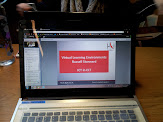What is Bubblr?
 |
| Bubblr, a comic strip making software by PimPamPum. |
Bubblr (http://www.pimpampum.net/bubblr/) is a free online software created by the company PimPamPum which allows its users to create a short comic/picture strips using the photos from Flickr.com. The users can also use their own photos if they have their own Flickr account.
 |
| ScreenShot 1: This is the homepage of the Bubblr website |
How to use it?
In order to create a comic/images strip in Bubblr, there are just a few easy and user friendly steps to follow. Here you go!
 |
| This flowchart shows the five simple steps to create Bubblr comic strip. |
Why do teachers and student like Bubblr?
1. Personalisation- Bubblr is all about personalisation and ownership. It gives teacher and students the opportunity to create own images strips based on own creativity and ways of expressing ideas. Students' creativity and thinking skills can be enhanced when they are planning their ideas as well as choosing and organising the images and putting in bubbles.
2. Engaging- It also has provided a chance for teacher to make the classroom learning environment to be more engaging because Bubblr is a combination of things such as choosing pictures and put in captions which students would be enjoy doing so much!
3. Building up writing skills- Students' writing skills can be built up slowly when they are trying to opt for the most suitable words to put in the bubbles in order to describe their images and convey their messages successfully.
How can Bubblr be used in ELT classroom?
1. Historical timeline- Bubblr would be a amazing tool used to illustrate a historical timeline because by its dynamic timeline structure.
For example, teacher can have students to produce a Bubblr strip to narrate the history of the students themselves. It could be a picture for each year, starting from the year they were born until the year which they are in now.
2. Procedure describing- Due to the scrolling linear feature of Bubblr, it can also be a great tool for students to describe the step-by-step procedures of performing an activity.
For example, the procedure of making a chocolate cake and the correct steps of brushing teeth. With the accompany of images and bubbles, the strip will look livelier if compared to the traditional flowchart.
3. Story creating based on images given by teacher- If a class has a Flickr account, it then allows the teacher to direct students to a certain resource and certain images to use.
For example, the teacher can upload a couple of images onto Flickr and have the students access them using the class username, then the teacher will ask the students to rearrange the images based on their imagination, and create a short story from that.
Some limitations of Bubblr
Despite of all the usefulness which have been stated above, Bubblr actually does have limitation as well.
1. Image placing- Once the images have been dragged down to the linear timeline structure, they cant be move around just by dragging. If the user has mistakenly put an image in a wrong place, he/she has to delete the image and add it again at the right position.
2. Bubble size- The thinking/ text bubble cannot be resized. Sometimes, the whole image would look nicer if the bubble can be resized and be put at the right position.
3. Bubble arrow- the arrow can just be moved around at the bottom of the bubble, but not at the side. It would make the placing of the bubble difficult occasionally if the user wants to point the arrow to something at the side of the bubble and do not want to block some part of the image.
Below is an example I did using Bubblr. The topic is Italy- which is one of the country I like the most. And this strip is showing some of the Italy main attractions and also my favourite Italian food. Enjoy and start to make yours too! (^_^)
For more detailed information, please visit http://www.teachertrainingvideos.com/bubblr/index.html. This is a teacher training video specially produced by my lecturer, Russell Stannard on the topic of how to use Bubblr.






















